Renderers
Visualization > Renderer
VRED offers four options under the Visualization > Renderer option. Use them to generate physically correct illustrations. For raytracers, all light sources will send rays to any point within its area of influence and the image generator will considers reflections and refraction of every ray on its calculation. If a renderer is greyed out, this indicates it is not supported by your hardware.
Use the Raytracing option ![]() in the toolbar to quickly toggle between using the Vulkan or OpenGL rasterizer, when off, and CPU Raytracing or GPU Raytracing, when on. When toggled on and off, VRED remembers the last used raytracer and rasterizer.
in the toolbar to quickly toggle between using the Vulkan or OpenGL rasterizer, when off, and CPU Raytracing or GPU Raytracing, when on. When toggled on and off, VRED remembers the last used raytracer and rasterizer.
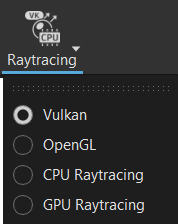
Use the Default Rasterizer and Default Raytracer preference settings to set the default rasterizer and raytracer used by VRED. Keep in mind, if your hardware cannot support your selection, VRED will default to an option it can.
OpenGL
OpenGL is a rasterizer that has no graphics card requirements and renders 2D and 3D vector graphics.
Vulkan
Vulkan is a rasterizer designed to replace the existing OpenGL rasterizer. It offers advanced GPU-accelerated hybrid rendering raytracing features, such as raytraced reflections, raytraced ambient occlusion, and raytraced environment shadows that require a raytracing-compatible graphics card for their use. This integration of rasterization and raytracing delivers visual results that are unattainable with OpenGL rasterization alone. Since this closely resembles the GPU raytracer in precompute mode, the transition between rasterization and raytracing is simplified. It also efficiently handles a large number of objects, especially when in motion, and doesn't have the light limitations of OpenGL, as all lights illuminate both geometry and volumes.
Video captions: When you launch VRED, you will notice the new Vulkan render engine being a new option in the Raytracing button of the main tool bar. With this new real-time render engine, we are using a next-generation real-time solution that is way better in handling large and complex scenes and allows us to mix rasterization rendering with aspects of raytracing.The new renderer efficiently handles a large number of objects, especially when in motion. It removes the limitation of lights present in OpenGL. With Vulkan, all lights will illuminate both geometry and volumes.
On top, we've implemented various optimizations to enhance rendering speed. One of them is occlusion culling which can be turned on in the visualization menu. Occlusion culling enhances performance by skipping the rendering of objects hidden by other objects and can have a significant positive impact depending on the type of scene.
But let’s also look at the visual enhancements that come with Vulkan. We now support hybrid raytracing. This enables the computation of realistic reflections and shadows, significantly enhancing the visual quality of your real-time scene in the viewport and bringing it closer to the results achievable with our CPU and GPU raytracers.
For example, VRED now can overlay raytraced reflections onto the rasterization image. Just go the File menu and select Raytraced Reflections under Visualization and you will see reflections on the corresponding objects like the door in this example.
We also introduced two new methods for calculating realtime shadows using raytracing: Raytraced Ambient Occlusion and Raytraced Environment Shadows. These methods are a more accurate and realistic alternatives to the still existing Screen Space Ambient Occlusion. Raytraced Ambient Occlusion functions similarly to SSAO, as it calculates shadows in all directions. Raytraced Environment Shadows, on the other hand, considers the lighting from the environment map to create soft shadows cast by brighter spots.
Another visual enhancement, while not being raytracing, is Screen Space Refractions. This visual effect in Vulkan offers a more realistic visualization of translucent materials, including surface roughness, by simulating light refraction in real time.
Vulkan also comes with a new way of displacement mapping that is faster and features correct self-shadowing through GPU tessellation. This approach significantly improves performance and accuracy. It can still be used in the materials as you know it from older versions of VRED.
We now support Line Tube radius for all materials with Vulkan, aligning more closely with the functionality of CPU and GPU raytracers. This enhancement allows you to apply any material to line geometry and set a radius to create tubes with caps at the end of the line geometry. You will find the settings within the Common section in the Material Editor of the assigned material.
Rasterization Settings
These Rasterization Settings contain options for evaluating shadows, reflections, refractions, and more with Vulkan.
Realtime Environment Shadows Settings
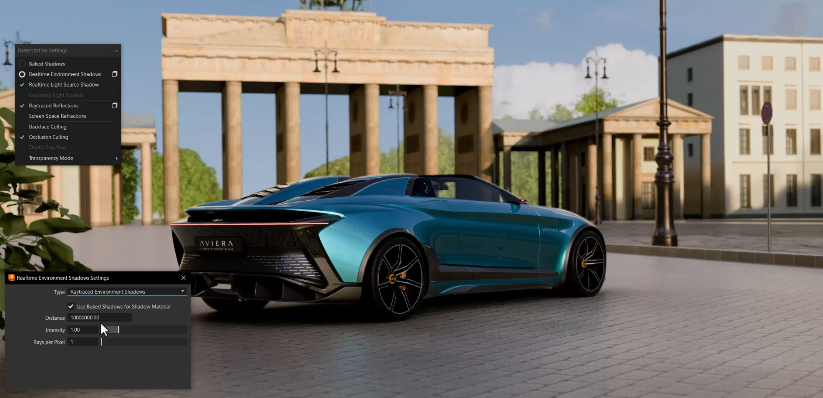
Find these methods, Raytraced Environment Shadows and Raytraced Ambient Occlusion, which require a raytracing-compatible graphics card, for calculating realtime shadows for diffuse lighting using raytracing. They are alternatives to the other shadow type, SSAO, which can be used by both Vulkan and OpenGL. Since realtime environment shadows can be quite performance intensive, they can also be disabled with Off.
Click ![]() to open the Realtime Environment Shadows Settings for determining the shadow type used, as well as whether baked shadows are used for shadow materials, the distance of the shadows, their intensity, and the number of rays per pixel.
to open the Realtime Environment Shadows Settings for determining the shadow type used, as well as whether baked shadows are used for shadow materials, the distance of the shadows, their intensity, and the number of rays per pixel.
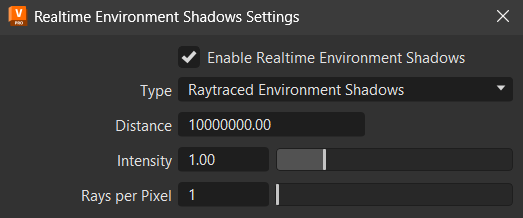
Raytraced Ambient Occlusion
Only available for Vulkan, as a raytracing-compatible graphics card is required. Use this alternative to SSAO for more accurate realtime computations of shadowed areas for diffuse lighting. It calculates shadows in all directions, making a scene illustration more realistic, while addressing some of SSAO's limitations.
Limitations: Tessellation (displacement maps) is not support; therefore, an untessellated version of the meshes will be used.
Raytraced Environment Shadows
Only available for Vulkan, as a raytracing-compatible graphics card is required. It uses raytracing and calculates approximate shadows for diffuse lighting, considering the lighting from the environment map, so that brighter areas have more importance, producing more defined, yet soft, shadows.
Limitations: Tessellation (displacement maps) is not support; therefore, an untessellated version of the meshes will be used.
Raytraced Reflections
Only available for Vulkan, as a raytracing-compatible graphics card is required. Raytraced reflections are supported for transparent material types, such as plastic, brushed metals, carpaint, carbon fiber, and MDL, as well as glass. Skinned meshes, DLSS-Ray Reconstruction, and Transparent/Multi Material reflection skinned meshes are also supported for raytraced reflections.
Raytracing support in Vulkan enables the computation of realistic reflections, significantly enhancing the visual quality of your realtime scene in the viewport. This brings your scene closer to results achieved with our CPU and GPU raytracers.
Find it in the Rasterization Settings options of the Visualization menu. Click ![]() to the left to open the Raytraced Reflections dialog for setting the number of layers of transparent surfaces visible in the reflections, from front to back. Any surfaces behind the specified number will not be visible in the reflections.
to the left to open the Raytraced Reflections dialog for setting the number of layers of transparent surfaces visible in the reflections, from front to back. Any surfaces behind the specified number will not be visible in the reflections.
| Raytraced Reflections OFF | Raytraced Reflections ON |
|---|---|
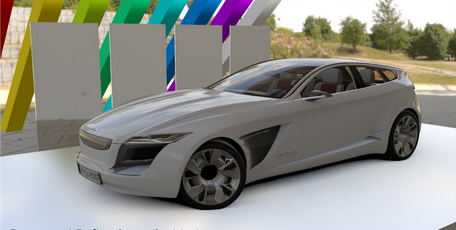 |
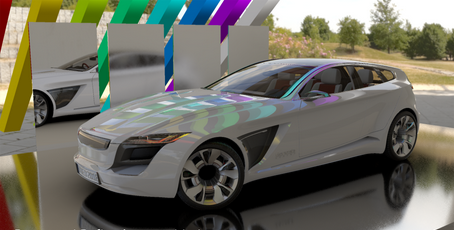 |
The following are specific things that are supported and visible in raytraced reflections:
Reflections on glass and transparent materials
Multipass and layered materials
Skinned meshes
Opaque materials
Area lights are accurately reflected
Nvidia realtime denoisers or DLSS-RR, when DLSS is enabled
Volumetrics raytraced reflections, when Reflect Volumes is enabled. Since these can slightly effect performance, they can be disabled. When playing back an animated volumetric reflection, enable DLSS to correct any lag in the reflected playback.
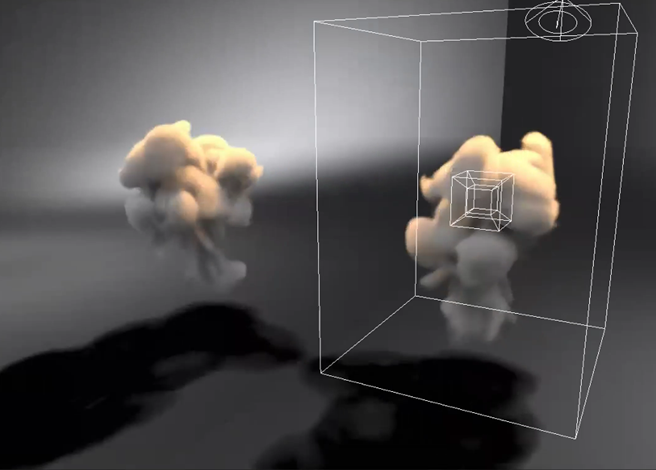
Limitations: Currently, since this is a realtime implementation, there are some limitations compared to VRED's full CPU and GPU raytracing:
Line and wireframe materials - These are excluded from Opaque materials.
Area lights without raytracing - These generate approximated light occlusion.
Reflections on glass and transparent materials - Only the front layer of a transparent object can have raytraced reflections.
Reflections - These are calculated only for the top-most layer of a material, such as the clearcoat, if present, or base layer, and the front-most sample of transparent objects. Only one bounce of reflection (one ray per pixel) is computed, so only direct reflections are visible. However, raytraced reflections for opaque and transparent objects are independent steps. This means a pixel can launch two rays, one for the opaque pass and another for the transparent pass.
For example, an object with an opaque material (e.g., a plastic without transparency) and no clearcoat will have glossy reflections raytraced. If the material contains a clearcoat, only the clearcoat reflections would be raytraced. The base layer (the actual plastic in this example) would use normal environment sampling.
For another example, with a transparent object (e.g. a plane) in front of an opaque object, both would have raytraced reflections, as they are calculated on different passes. If a transparent object is in front of another transparent object, only the samples closest to the camera would be raytraced, while the samples behind would fallback to environment sampling.
Tessellation (displacement maps) - These are not yet supported; therefore, an untessellated version of the meshes will be used.
When a mesh with displacement is visible on the reflections, the "flat" version is shown. This situation can produce artefacts when the information from rasterization and raytracing don't match.
For example, when calculating Raytraced Ambient Occlusion for a mesh with displacement, as the rays are generated from the displaced mesh, rays collide against the non-displaced mesh. This is more pronounced with concave geometry or displacements that move the geometry inwards, as these produce self-shadowing. Self-shadowing can show on Substance materials, which use displacement maps with height values of 0.5 as "no displacement". These surfaces are indented for values < 0.5. A workaround is to change the Displacement Offset in the VRED Substance material from 0.5 to 0.0.
Screen Space Refractions
Only available for Vulkan. Screen Space Refraction (SSR) adds realism to translucent and transparent materials, such as glass and plastic, by simulating light refraction in realtime. This feature is limited to the transparent layer closest to the camera and any additional transparent materials behind it will be ignored. Refractions will not match the results on the CPU or GPU raytracers. Find it in the Rasterization Settings options of the Visualization menu.
| OpenGL | Vulkan |
|---|---|
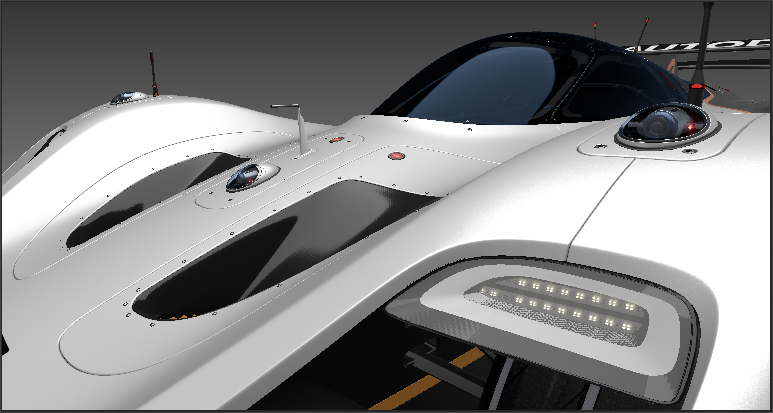 |
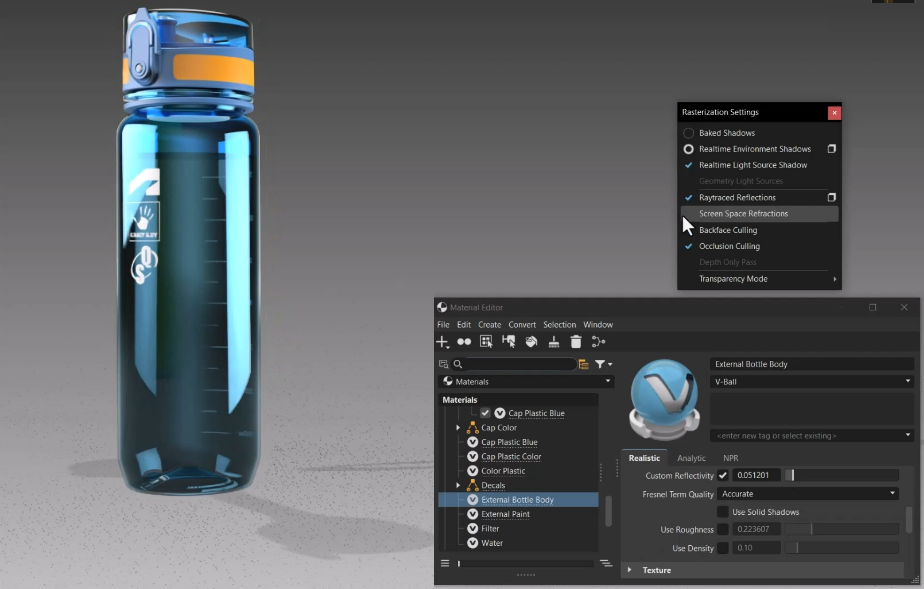 |
Limitations: Currently, since this is a realtime implementation, there are some limitations:
- Transparency - This feature is limited to the transparent layer closest to the camera and any additional transparent materials behind it will be ignored.
- DLSS-RR - This produces artifacts when Screen Space Refractions are used. To avoid this, use the default denoiser when Screen Space Refractions are in use. A drop in quality is expected in this situation, as the default denoiser tends to produce worse results and introduces more lag.
- DLSS - If DLSS is enabled when Screen Space Refractions is in use, a lower resolution is rendered initially, denoised with the default denoiser, and then it is upscaled by DLSS. For this reason, Screen Space Refractions + DLSS tends to produce a lower quality result than Screen Space Refractions without DLSS.
Environment Lights
Environment lights are a way to create lights using bright spots in environment images.
Limitations: Vulkan currently only supports one set of environment lights, which are coming from the active environment configured in the World. Objects with materials that use the same environment as the World's active environment will be illuminated by the environment lights, while objects using a different environment will not.
Environment lights are occluded by any objects in the scene that cast shadows independently of the environment configured in their material.
Note: For an environment material, when Shadow Lightsources is not set to 0, the environment light map is modified to compensate for illumination coming from the lights generated from the environment, making the scene darker. For this reason, Shadow Lightsources should only be enabled for an environment configured as active in the world, and any local environments should have light generation disabled to achieve the correct behavior. If a local environment (one assigned to a material, but not configured as active in the world) has light generation enabled, the object will appear darker than it should, as it will be missing illumination from the lights.
Line Tubes
Line tubes are supported for Vulkan. Apply any material to line geometry and set a thickness for a tube radius that is uniform along the whole line. The lines are approximated by a number of connected capsules. In some situations, the capsule caps can be seen between line segments. To control the line thickness, use the Line Tube Radius option in the Material Editor > Common section.
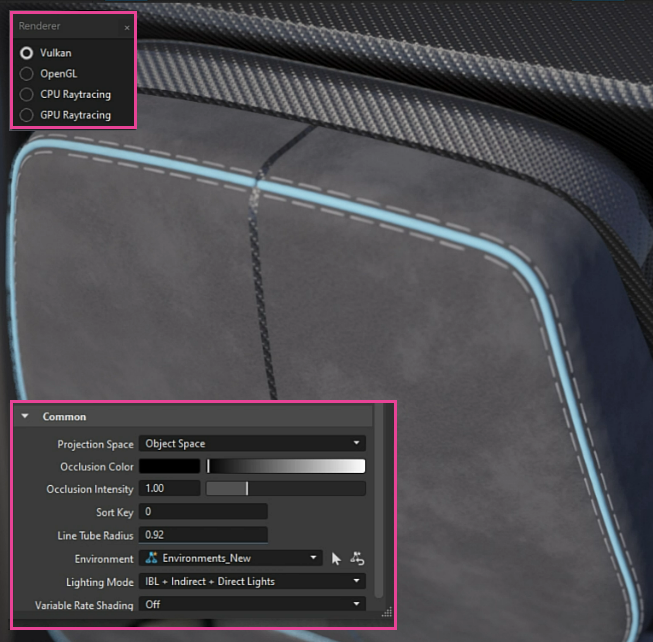
Limitations: Currently, since this is a realtime implementation, there are some limitations:
- Some line tube geometries in VRED do not have texture coordinates. Line tubes only have texture coordinates when the source line geometry has texture coordinates.
- Materials that use texture coordinates should be avoided.
- Line tube radius is not working in raytraced reflections. The default radius (1 unit) is used; however, this usually means that tube lines are too thin.
Hardware Tessellated Displacement Mapping
Hardware tessellated displacement mapping is supported and provides significantly better visual quality with minimal impact to performance. It adds fine details to surfaces using the displacement map texture, creating more complex geometry without a high-polygon base mesh. Whenever a material is loaded, uses a displacement texture, and the Displacement Height setting is greater than 0, hardware tessellated displacement mapping is used.
Display Clusters
Frontplates and backplates are fully supported.
Limitations: Currently, since this is a realtime implementation, there are some limitations:
- Tonemapping
- Raytracing denoising
- Auxiliary visualizations - Things like bounding boxes and transform manipulators are not shown on Vulkan display clusters
- DLSS for raytracing is disabled on smaller sizes. If the render size is smaller than 129 x 193 pixels, DLSS will be disabled, which will produce noisy results.
Materials
As of VRED 2026.1, Shadow materials support raytraced glossy reflections. Find the Glossy Only option in the Material Editor > Reflection > Reflection Mode. And, we added support for OCS materials.
The following are not yet supported: X-Rite Car Paint v1 (X-Rite Car Paint v2 is supported), X-Rite BTF, and Chunk Materials.
The following are deprecated or will not be implemented: Velvet, Woven Cloth (try using a Substance, MaterialX, or MDL as replacement), Line Chrome (try using a chrome material on a line tube instead), and Chrome Smear (as it is not supported by the GPU Raytracer).
Limitations: Currently, since this is a realtime implementation, there are some limitations:
- Glass texture projections might look different when using non-default values for per-texture Repeat, Offset, or Rotation settings.
- Translucent and Volumetric SVBRDF AxF materials rendering is approximate (similar to OpenGL) as Vulkan does not have a subsurface scattering implementation yet.
- X-Ray material shows all camera-facing surfaces of an object including self-occluded parts, not just the front-most surfaces of an object.
General Limitations
The following are a list of general limitations.
- Fog - The camera fog option is not supported in Vulkan. A scatter volume can be used instead.
- Geometry Lights - Vulkan does not supports geometry lights, so they do not produce any illumination. Enable Raytraced Reflections to see glossy and specular reflections of geometry lights, same as for any other objects.
- Multi-GPU - Currently Vulkan can only use one GPU.
- Multi-material - For multi-materials, such as multipass and layered materials, all sub-materials use the same ray, which is generated from the blend of all material properties. This is not accurate and prevents some effects, like using a glass material on top of an opaque material to simulate a clearcoat.
- Raytracing Features - Raytraced reflections, raytraced ambient occlusion, and raytraced environment shadows are not supported on AMD GPUs in VRED 2026. When loading a file with such options enabled, on a system with an AMD GPU, they are automatically disabled.
- Render Modes - Surface Analysis and Non-Photorealistic rendering modes are not supported. To access these modes, switch to the OpenGL renderer.
- Subsurface Scattering - Like in OpenGL, currently Vulkan does not support subsurface scattering.
- Transparent Object Sorting - At the moment, Vulkan only supports depth peeling for rendering transparent objects in the correct order. This method ensures the correct visualization of transparent surfaces, even within the same object; but, it is slower than normal object sorting and is limited by the number of layers supported (number of transparent samples for a given pixel). Depth Peeling can produce visual artefacts when that limit is reached.
- Variable Shading Rate - This is not yet supported in Vulkan.
CPU Raytracing
Raytracing > CPU Raytracing or Visualization > Renderer > CPU Raytracing
There are features within VRED that are yet supported on the GPU, and some probably never will be, such as some of the pixelfilter or quality overrides. CPU Raytracing is more accurate than the GPU, and can access system RAM, which can be crucial when rendering very large or complex scenes, and when using photonmapping, you might get better performance with CPU raytracing.
Denoising
For denoising using your CPU to save a lot of GPU memory when rendering a huge image, in Render Settings > General Settings > Antialiasing, choose a denoiser from the Denoiser option, then for the Denoiser Type, select Open Image Denoiser.
GPU Raytracing
Raytracing > GPU Raytracing or Visualization > Renderer > GPU Raytracing
Available for VRED Professional. For VRED Design, though GPU Raytracing is available for accessing the Bake Light and Shadows module, it is limited to one GPU.
Video captions: Available as of VRED 2025.3. I'm happy to announce that we have unlocked GPU Raytracing in VRED Design. And as a result, you can now bake texture based lightmaps using the GPU in VRED Design.
Video Captions: In VRED 2021, we are now able to do raytracing on the graphics card. On the Raytracing button in the main menu, we added now a dropdown menu, where you are able to switch between from OpenGL, CPU, and GPU raytracing. You can also use NVIDIA's denoising, additionally. The denoising quality can be set with the Realtime Antialiasing quality settings. The new feature is supported with Turing, Volta, Pascal, and Maxwell cards, while RTX is recommended, and we support 2 graphic cards per one VRED Pro license. This new feature gives you the maximum flexibility for your hardware choices. Thanks for watching the video.
With GPU Raytracing, fewer rays are sent from the light sources on camera movement to enable smooth navigation within the Render Window.
Press F4 to start GPU raytracing. To switch back to OpenGL, press F3.
Enabling Stillframe Antialiasing affects not only the smoothing of the illustration's edges, it increases the number of rays and reflections considered during image calculation. The more allotted to time calculation, the less noise within the image.
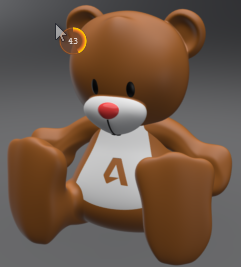
Requirements for GPU Raytracing
If your system does not meet the requirements, GPU Raytracing will be unavailable through the Raytracing and Visualization menus. Beyond the information provided below, check out this forum post for answers to more complicated setups and scenarios.
For GPU Raytracing, your version of VRED determines the recommended NVIDIA® driver. As always, see the system requirements for the latest recommendations and any exceptions. Also, keep in mind, larger scenes require 8GB or more GPU memory.
For Windows Users using DLSS-RR:
| VRED | NVIDIA Driver |
|---|---|
| 2026 | 553.62 or above |
| 2025.1 - 2025.3 | 536.67 or above |
| 2025 | 537.13 or above |
| 2024 - 2024.2 | 537.02 or above |
For Windows Users:
| VRED | NVIDIA Driver |
|---|---|
| 2026 | 551.23 or above |
| 2025.3 | 551.23 or above |
| 2025.1 - 2025.2 | 536.67 or above |
| 2025 | 527.41 or above |
| 2024 - 2024.2 | 516.10 or above |
For Linux Users using DLSS-RR:
| VRED | NVIDIA Driver |
|---|---|
| 2026 | 550.54 or above |
| 2025 - 2025.3 | 535.104 or above |
| 2024 - 2024.1 | 515.43.04 or above |
For Linux Users:
| VRED | NVIDIA Driver |
|---|---|
| 2026 | 550.54 or above |
| 2025.3 | v.550.54 or above |
| 2025.1 - 2025.2 | v.535.86 or above |
| 2025 | 525.60 or above |
| 2024 - 2024.1 | 515.43.04 or above |
The driver is available under Advanced search on the NVIDIA website here.
GPU Raytracing works on NVIDIA Turing, Volta, Pascal, and Maxwell GPUs. We highly recommend RTX GPUs.
Multiple GPUs will improve performance and only homogenious GPU setups are supported, as mixed can cause poor performance.
As of VRED 2022.1, GPU Raytracing uses Optix 7.2 and CUDA 11.1 to enable denoising on multiple GPUs.
For optimal performance with 2x GPUs, we recommend enabling SLI and using a NVLink-Bridge.
For more than 2 GPUs, the settings are not relevant; however, you may need to consult the following section.
Windows Users and More Than 6 GPUs
Due to limitations of the virtual address space in Microsoft Windows, using more than 6 GPUs in a NVLink configuration requires setting VRED_DISABLE_CUDA_MEMORY_POOL_SUPPORT as an environment variable. Disabling the usage of the memory pool will reduce scene initialization and update performance.
For instruction on entering environment variables, see Where To Enter Environment Variables.
As of version 2022.1, there is Cryptomatte support in GPU Raytracing.
 Recent Improvements
Recent Improvements
Check this section each release to find the latest improvements.
In 2026.2, for Vulkan, we added support for OpenColorIO for the color grading and auxiliary nodes. We also improved the raytraced and raytraced ambient occlusion environment shadow quality when DLSS is disabled and optimized memory usage with the introduction of MSAA, which decreases VRAM usage by up to 10% when enabled and used along with realtime raytracing effects, such as Raytraced Reflections, Raytraced Ambient Occlusion, or Raytraced Environment Shadows..
In 2026.1, we added a new command line parameter,
--renderer, which overrides the default rasterizer or raytracer set in the preferences.For Vulkan, we added support for Shadow material raytraced glossy reflections, Volumetrics raytraced reflections, OCS materials, and glow and glare, chromatic aberration, camera grain, vignetting, and camera blends in Display Clusters. For a complete list, see Vulkan - New Features and Improvements.
For GPU Raytracing, we reduced memory consumption and fixed performance for the later NVIDIA drivers, improved performance when compressing textures on CUDA-capable systems, and for brushed metal, we significantly reduced the noise that used to occur in a blending region, resulting in nicer blended textures.
In 2026, we added support for runtime texture compression to GPU Raytracing, which compresses textures when uploading them to the GPU without changing the original images. We also renamed the preference, Use OpenGL Texture Compression, to Use GPU Texture Compression.
In 2025.3, for VRED Design users, we added support for GPU Raytracing.
In 2025.2, we added the Optimization Mode option, which enables you to choose the optimization strategy used to GPU raytrace and support for block compressed textures generated by the
vrMaterialService.compressTextures()command.In 2025.1, we added support for looking into a ray file when GPU raytracing.
In 2025, for rendering, we added support for translucent X-Rite AxF materials with or without surface roughness, made AgX Color Space our new tonemapper, and improved performance, as well as the Volume Scatter material by adding falloff attributes for controlling the fading out of Volume Scatter materials in X, Y, and/or Z.
In 2024.1, we implemented the new NVIDIA library to help avoid self-intersection issues when GPU raytracing.
We also removed shadow material shadows from the Albedo buffer to improve denoising results.
GPU Raytracing Limitations
At the moment, not all features in CPU Raytracing are supported in GPU Raytracing. Here's a list of current limitations, excluding functionality that still needs to be implemented:
- NURBS
- Chrome saturation and contrast cannot be changed
- Woven Cloth basic colors are only supported
- Layered glass on glass is not supported
- Quality Overrides are only partially supported
- Pixel Filter sharp variants are only supported
- Renderlayer is visible in Alpha
- Offline Rendering has missing sceneplates and old versions of Glow/Glare
As of version 2022.1, there is Cryptomatte support in GPU Raytracing.
Activating GPU Raytracing
To activate GPU raytracing, in the toolbar, select Raytracing > GPU Raytracing or Visualization > Raytracing > GPU Raytracing.

If this option is grayed out, it means your system doesn't meet the minimum system requirements. You need an NVIDIA Maxwell gen GPU or newer and a version 441.66 driver or newer.
GPU raytracing supports video textures, such as videos streaming on a backplate. The video illuminates the whole scene.
It also supports data prep rendering modes, such as Vertex/Face Normal Rendering, for fixing your normals in GPU raytracing.
Can I GPU Raytrace Using Remote Desktop?
Yes. If you have to remotely access your rendering workstation, you will need Quadro GPUs.
NVIDIA provides Windows Remote Desktop support for NVIDIA GeForce GPUs, a feature that has previously only been available on enterprise Quadro boards.
Log on as an NVIDIA Developer to get access. After this, a link will enable you to access the software you’ll need: https://developer.nvidia.com/designworks
You must use GeForce drivers R440 or later. Once you download, launch the executable as administrator on the machine running the OpenGL application to enable OpenGL acceleration. A dialog will be displayed to show whether OpenGL was enabled and if rebooting is required.
Future GeForce 440 and 445 drivers will have the capability built in, so you won’t need this patch.
GPU vs CPU Raytracing
When raytracing, we compared a Dual CPU Workstation with 40Cores/80Threads in total with 1, 2, and 3 RTX 8000 GPUs. Here are the results:
- 1 RTX 8000 GPU was about 2.3 times faster than the Workstation.
- 3 RTX 8000 GPUs were about 6.6 times faster than the CPU Raytracer.
However, there are some things to keep in mind:
The comparisons were made with the same scene settings.
Not all features are yet supported on the GPU, and some probably never will be, such as some of the pixelfilter or quality overrides. So, when using photonmapping, you might get better performance with CPU raytracing.
A GPU with lots of memory is needed to work with standard automotive datasets. For professional work, at a minimum, we recommend, a Quadro RTX 5000, Titan RTX (not officially supported), or Quadro RTX 6000. For large scenes, use a Quadro RTX 8000.
As of version 2021.3, memory sharing, via NVlink, is supported. It is important to note that this will have a cost to performance and currently only works on Windows.